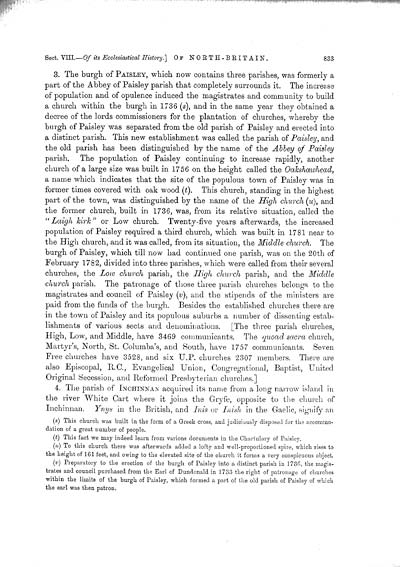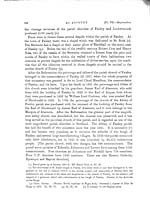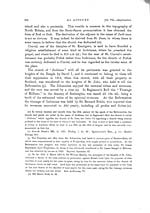Volume 6
(393) Page 833
Download files
Individual page:
Thumbnail gallery: Grid view | List view

833 3. The burgh of PAISLEY, which now contains three parishes, was formerly a part of the Abbey of Paisley parish that completely surrounds it. The increase of population and of opulence induced the magistrates and community to build a church within the burgh in 1736 (s), and in the same year they obtained a decree of the lords commissioners for the plantation of churches, whereby the burgh of Paisley was separated from the old parish of Paisley and erected into a distinct parish. This new establishment was called the parish of Paisley, and the old parish has been distinguished by the name of the Abbey of Paisley parish. The population of Paisley continuing to increase rapidly, another church of a large size was built in 1756 on the height called the Oakshawhead, a name which indicates that the site of the populous town of Paisley was in former times covered with oak wood (t). This church, standing in the highest part of the town, was distinguished by the name of the Sigh church (u), and the former church, built in 1736, was, from its relative situation, called the "Laigh kirk" or Low church. Twenty-five years afterwards, the increased population of Paisley required a third church, which was built in 1781 near to the High church, and it was called, from its situation, the Middle church. The burgh of Paisley, which till now had continued one parish, was on the 20th of February 1782, divided into three parishes, which were called from their several churches, the Low church parish, the High church parish, and the Middle church parish. The patronage of those three parish churches belongs to the magistrates and council of Paisley (v), and the stipends of the ministers are paid from the funds of the burgh. Besides the established churches there are in the town of Paisley and its populous suburbs a number of dissenting estab- lishments of various sects and denominations. [The three parish churches, High, Low, and Middle, have 3469 communicants. The quoad sacra church, Martyr's, North, St. Columba's, and South, have 1757 communicants. Seven Free churches have 3528, and six U.P. churches 2307 members. There are also Episcopal, R.C., Evangelical Union, Congregational, Baptist, United Original Secession, and Reformed Presbyterian churches.] 4. The parish of INCHINNAN acquired its name from a long narrow island in the river White Cart where it joins the Gryfe, opposite to the church of Inchinnan. Ynys in the British, and Inis or Inish in the Gaelic, signify an (s) This church was built in the form of a Greek cross, and judiciously disposed for the accommo- dation of a great number of people. (t) This fact we may indeed learn from varions documents in the Chartulary of Paisley. (w) To this church there was afterwards added a lofty and well-proportioned spire, which rises to the height of 161 feet, and owing to the elevated site of the church it forms a very conspicuous object. (v) Preparatory to the ereetion of the burgh of Paisley into a distinct parish in 1736, the magis- trates and council purchased from the Earl of Dundonald in 1733 the right of patronage of churches within the limits of the burgh of Paisley, which formed a part of the old parish of Paisley of which the earl was then patron.
Set display mode to:
![]() Universal Viewer |
Universal Viewer | ![]() Mirador |
Large image | Transcription
Mirador |
Large image | Transcription
Images and transcriptions on this page, including medium image downloads, may be used under the Creative Commons Attribution 4.0 International Licence unless otherwise stated. ![]()
| Caledonia, or, An account, historical and topographic of North Britain from the most ancient to the present times > Volume 6 > (393) Page 833 |
|---|
| Permanent URL | https://digital.nls.uk/74531816 |
|---|---|
| Description | Vol. VI. |
|---|---|
| Attribution and copyright: |
|

